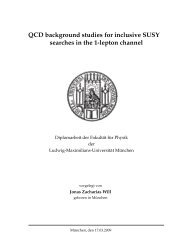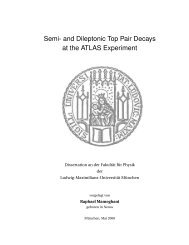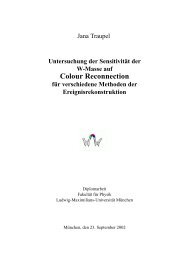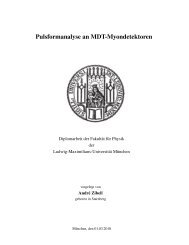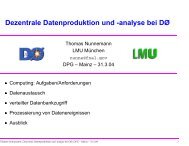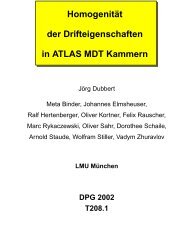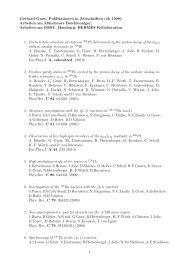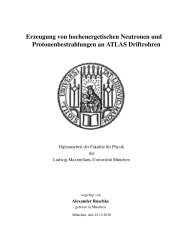development of micro-pattern gaseous detectors – gem - LMU
development of micro-pattern gaseous detectors – gem - LMU
development of micro-pattern gaseous detectors – gem - LMU
Create successful ePaper yourself
Turn your PDF publications into a flip-book with our unique Google optimized e-Paper software.
4.3. Cosmic Muon Spectrum 45<br />
4.3 Cosmic Muon Spectrum<br />
The 55 Fe source served well for determination <strong>of</strong> the energy resolution since it provides a discrete<br />
line spectrum for calibration. However, X-rays do not provide an external trigger and therefore can<br />
not be used to evaluate, for example, the efficiency (see Ch. 5) <strong>of</strong> the triple GEM detector.<br />
Looking for sources with higher energies, the omnipresent cosmic ray muons are a favorable choice<br />
for further detector tests. Their energies are high enough to trigger the scintillation counters while<br />
still penetrating the detector. This section illustrates the characteristics <strong>of</strong> cosmic muons as minimum<br />
ionizing particle (MIPs) and reports on measurements <strong>of</strong> their spectrum with the prototype 1.0.<br />
4.3.1 Pulse Height Spectrum <strong>of</strong> Cosmics<br />
4000<br />
Cu anode unseg<br />
Δ U<strong>gem</strong>3=<br />
360 V<br />
data_<strong>gem</strong>_0062_pulseheight_fit<br />
3500<br />
preamp: CATSA82<br />
Δ U<strong>gem</strong>2=<br />
340 V<br />
Δ U<strong>gem</strong>1=<br />
320 V<br />
Entries<br />
Mean<br />
36697<br />
27.85<br />
3000<br />
2500<br />
2000<br />
1500<br />
1000<br />
500<br />
Cosmics Pulse Height<br />
cm<br />
kV<br />
Edrift<br />
= 1.25<br />
cm<br />
kV<br />
Eind<br />
= Etrans1,2<br />
= 2.00<br />
RMS 20.42<br />
χ 2 / ndf<br />
132.3 / 92<br />
Prob 0.003768<br />
Constant 1.732e+04 ± 1.491e+02<br />
MPV 14.79 ± 0.12<br />
Sigma 4.535 ± 0.037<br />
Landau<br />
0 20 40 60 80 100 120<br />
voltage [0.244mV]<br />
Figure 4.8: Pulse height spectrum <strong>of</strong> cosmic muons recorded with prototype 1.0 and single plane readout.The<br />
spectrum is cut <strong>of</strong>f due to preamplifier performance.<br />
Muons account for 80% <strong>of</strong> all charged cosmic ray particle at ground level [Grup 08]. A minimum<br />
ionizing muon, that is a particle <strong>of</strong> βγ ≈ 4, carries an energy <strong>of</strong> Eµ ≈ 420 MeV. In a <strong>gaseous</strong> environment<br />
<strong>of</strong> Ar/CO2 at a fraction <strong>of</strong> 93/7 this muon creates approximately 97 primary electron-ion-pairs<br />
per cm due to inonization [PDG 10]. According to this and considering the dimension <strong>of</strong> the detector,<br />
about 39 primary electrons are realeased by a cosmic ray muon that penetrates the drift region<br />
perpendicular to the active area. Since the angular distribution <strong>of</strong> cosmic ray muons is proportional to<br />
cos 2 θ, with θ being the zenith angle, this is the most probable value to assume [PDG 10]. For a given<br />
maximal incident angle <strong>of</strong> θ = 63 ◦ , that is defined as the zenith angle <strong>of</strong> a muon hitting the inner<br />
edges <strong>of</strong> both scintillators (see Ch. 5.1), this number increases to approximately 86 charges in the<br />
drift gap. As discussed in Ch. 1.1.1 this calculation holds for the average energy loss <br />
dE<br />
dx which is<br />
denoted by the mean in the presented histogram. As the prototype 1.0 contains a drift gap <strong>of</strong> 4 mm, it<br />
can be treated as a thin absorber and a Landau distribution is used to describe the muon’s energy distribution<br />
(see Ch. 1.1.1). Fig. 4.8 illustrates such a distribution as it is taken with the first detector setup.<br />
The data taking <strong>of</strong> cosmics with an equivalent sample size compared to 55 Fe X-rays is achieved during



